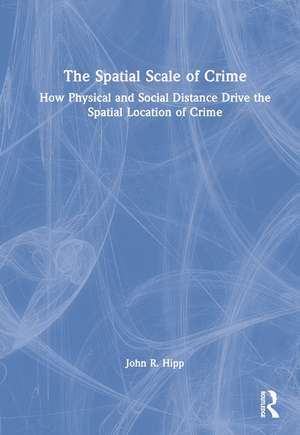The Spatial Scale of Crime: How Physical and Social Distance Drive the Spatial Location of Crime
Autor John R. Hippen Limba Engleză Hardback – 9 dec 2022
A characteristic of many crime incidents is that they happen at a particular spatial location and a point in time. These two simple insights suggest the need for both a spatial and a longitudinal perspective in studying crime events. The spatial question focuses on why crime seems to occur more frequently in some locations than others, and the consequences of this for certain areas of cities, or neighborhoods. The longitudinal component focuses on how crime impacts, and is impacted by, characteristics of the environment. This book looks at where offenders, targets, and guardians might live, and where they might spatially travel throughout the environment, exploring how vibrant neighborhoods are generated, how neighborhoods change, and what determines why some neighborhoods decline over time while others avoid this fate.
Hipp’s theoretical model provides a cohesive response to the general question of the spatial scale of crime and articulates necessary future directions for the field. This book is essential for students and scholars interested in spatial-temporal criminology.
WINNER of the 2023 James Short Senior Scholar Award!
| Toate formatele și edițiile | Preț | Express |
|---|---|---|
| Paperback (1) | 363.68 lei 6-8 săpt. | |
| Taylor & Francis – 9 dec 2022 | 363.68 lei 6-8 săpt. | |
| Hardback (1) | 898.77 lei 6-8 săpt. | |
| Taylor & Francis – 9 dec 2022 | 898.77 lei 6-8 săpt. |
Preț: 898.77 lei
Preț vechi: 1096.05 lei
-18% Nou
Puncte Express: 1348
Preț estimativ în valută:
172.03€ • 186.93$ • 144.60£
172.03€ • 186.93$ • 144.60£
Carte tipărită la comandă
Livrare economică 21 aprilie-05 mai
Preluare comenzi: 021 569.72.76
Specificații
ISBN-13: 9781032202389
ISBN-10: 1032202386
Pagini: 274
Ilustrații: 1 Tables, black and white; 28 Line drawings, black and white; 28 Illustrations, black and white
Dimensiuni: 178 x 254 x 18 mm
Greutate: 0.7 kg
Ediția:1
Editura: Taylor & Francis
Colecția Routledge
Locul publicării:Oxford, United Kingdom
ISBN-10: 1032202386
Pagini: 274
Ilustrații: 1 Tables, black and white; 28 Line drawings, black and white; 28 Illustrations, black and white
Dimensiuni: 178 x 254 x 18 mm
Greutate: 0.7 kg
Ediția:1
Editura: Taylor & Francis
Colecția Routledge
Locul publicării:Oxford, United Kingdom
Cuprins
Chapter 1. Introduction: Understanding Crime in Neighborhoods
Chapter 2. A General Theory of Spatial Crime Patterns: Explaining Where Crime Occurs
Chapter 3. What Is a Neighborhood? Spatial Social Networks and Egohoods
Chapter 4. How Do We Learn About Crime and Disorder?
Chapter 5. How Do Residents Respond to Neighborhood Crime?: The EVLN Model
Chapter 6. Why Doesn’t Everyone Choose "Voice"?
Chapter 7. Social Distance, Physical Distance, and Social Networks
Chapter 8. Temporal Scale: Stability and Dynamic Neighborhoods
Chapter 9. Larger Units of Analysis: How Do Small-Scale Processes Scale Up?
Chapter 10. Conclusion: Where Are the Implications Of All This?
Chapter 2. A General Theory of Spatial Crime Patterns: Explaining Where Crime Occurs
Chapter 3. What Is a Neighborhood? Spatial Social Networks and Egohoods
Chapter 4. How Do We Learn About Crime and Disorder?
Chapter 5. How Do Residents Respond to Neighborhood Crime?: The EVLN Model
Chapter 6. Why Doesn’t Everyone Choose "Voice"?
Chapter 7. Social Distance, Physical Distance, and Social Networks
Chapter 8. Temporal Scale: Stability and Dynamic Neighborhoods
Chapter 9. Larger Units of Analysis: How Do Small-Scale Processes Scale Up?
Chapter 10. Conclusion: Where Are the Implications Of All This?
Notă biografică
John R. Hipp is Professor in the Departments of Criminology, Law and Society, and Sociology, at the University of California, Irvine. His research interests focus on how neighborhoods change over time, how that change both affects and is affected by neighborhood crime, and the role networks and institutions play in that change. He approaches these questions using quantitative methods as well as social network analysis. He has published substantive work in such journals as American Sociological Review, Criminology, Social Forces, Social Problems, Mobilization, City & Community, Urban Studies, and Journal of Urban Affairs. He has published methodological work in such journals as Sociological Methodology, Psychological Methods, and Structural Equation Modeling.
Descriere
Combining insights from two distinct research traditions—the communities and crime tradition that focuses on why some neighborhoods have more crime than others, and the burgeoning crime and place literature that focuses on crime in micro-geographic units—this book expores the spatial scale of crime.
